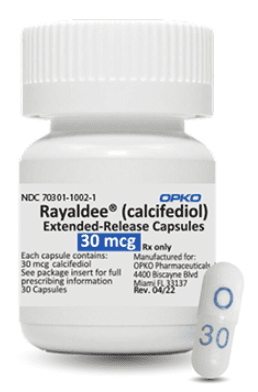Calcifediol Side Effects
Medically reviewed by Drugs.com. Last updated on Jun 10, 2025.
Applies to calcifediol: oral capsule extended release.
Precautions
It is very important that your doctor check your progress at regular visits to make sure that this medicine is working properly. Blood and other laboratory tests may be needed to check for unwanted effects.
Hypercalcemia may occur while you are using this medicine. Tell your doctor right away if you are feeling tired, trouble thinking clearly, loss of appetite, nausea, vomiting, constipation, increase thirst, increased urination, or weight loss.
This medicine may cause adynamic bone disease (low bone turnover) with high risk of fractures. Tell your doctor right away if you have pain or swelling in the arms or legs without any injury.
Do not take other medicines unless they have been discussed with your doctor. This includes prescription or nonprescription (over-the-counter [OTC]) medicines and herbal or vitamin supplements.
Serious side effects of calcifediol
Along with its needed effects, calcifediol may cause some unwanted effects. Although not all of these side effects may occur, if they do occur they may need medical attention.
Check with your doctor immediately if any of the following side effects occur while taking calcifediol:
Less common side effects
- abdominal or stomach pain
- chest pain
- confusion
- cough
- cough producing mucus
- increased urine output
- difficulty with breathing
- difficulty with moving
- dilated neck veins
- extreme fatigue
- fever or chills
- irregular breathing
- irregular heartbeat
- muscle pain or stiffness
- nausea or vomiting
- nervousness
- numbness or tingling in the hands, feet, or lips
- pain, swelling, or redness in the joints
- pale skin
- sneezing
- sore throat
- swelling of the face, fingers, feet, or lower legs
- tightness in the chest
- troubled breathing with exertion
- unusual bleeding or bruising
- unusual tiredness or weakness
- weakness or heaviness of the legs
- weight gain
Incidence not known
- confusion
- constipation
- depression
- dry mouth
- headache
- incoherent speech
- increased urination
- loss of appetite
- metallic taste
- muscle weakness
- thirst
- weight loss
Get emergency help immediately if any of the following symptoms of overdose occur while taking calcifediol:
Symptoms of overdose
- decreased appetite
- increased urination
- dizziness
- dry mouth
- fainting
- high urine levels of calcium
- increase in heart rate
- irritability
- lightheadedness
- muscle weakness
- rapid breathing
- sunken eyes
- wrinkled skin
Other side effects of calcifediol
Some side effects of calcifediol may occur that usually do not need medical attention. These side effects may go away during treatment as your body adjusts to the medicine. Also, your health care professional may be able to tell you about ways to prevent or reduce some of these side effects.
Check with your health care professional if any of the following side effects continue or are bothersome or if you have any questions about them:
- Bruise
- muscle aches
- stuffy or runny nose
See also:
For healthcare professionals
Applies to calcifediol: oral capsule, oral capsule extended release.
Metabolic adverse events
Metabolic side effects have included hypercalcemia, and increased phosphate absorption.[Ref]
Early signs and symptoms of hypercalcemia include headache, anorexia, nausea, vomiting, metallic taste, constipation, abdominal cramps, dry mouth, weakness, fatigue, muscle and bone pain, ataxia, tinnitus, and vertigo. Later hypercalcemia may result in pruritus, mental confusion, coma, hypertension, cardiac arrhythmias, seizures, metastatic calcification, and renal insufficiency manifested by polyuria, nocturia, polydipsia, and proteinuria. Patients with renal failure are more prone to the development of hypercalcemia because the urinary excretion of calcium cannot compensate for increases in serum calcium.
Increased phosphate absorption may be detrimental in patients with chronic renal failure and hyperphosphatemia.
Because of the long half-life of calcifediol, reversal of toxic symptoms may take 7 to 30 days.[Ref]
References
1. Miller SM (1983) "New perspectives on vitamin D." Am J Med Technol, 49, p. 27-37
2. Araugo OE, Flowers FP, Brown K (1991) "Vitamin D therapy in psoriasis." DICP, 25, p. 835-9
3. (1982) "Calcifediol for renal osteodystrophy." Med Lett Drugs Ther, 24, p. 92-3
4. (2001) "Product Information. Calderol (calcifediol)." Organon
Frequently asked questions
More about calcifediol
- Check interactions
- Compare alternatives
- Reviews (7)
- Dosage information
- During pregnancy
- Drug class: vitamins
- En español
Patient resources
Other brands
Professional resources
Other brands
Related treatment guides
Further information
Calcifediol side effects can vary depending on the individual. Always consult your healthcare provider to ensure the information displayed on this page applies to your personal circumstances.
Note: Medication side effects may be underreported. If you are experiencing side effects that are not listed, submit a report to the FDA by following this guide.

